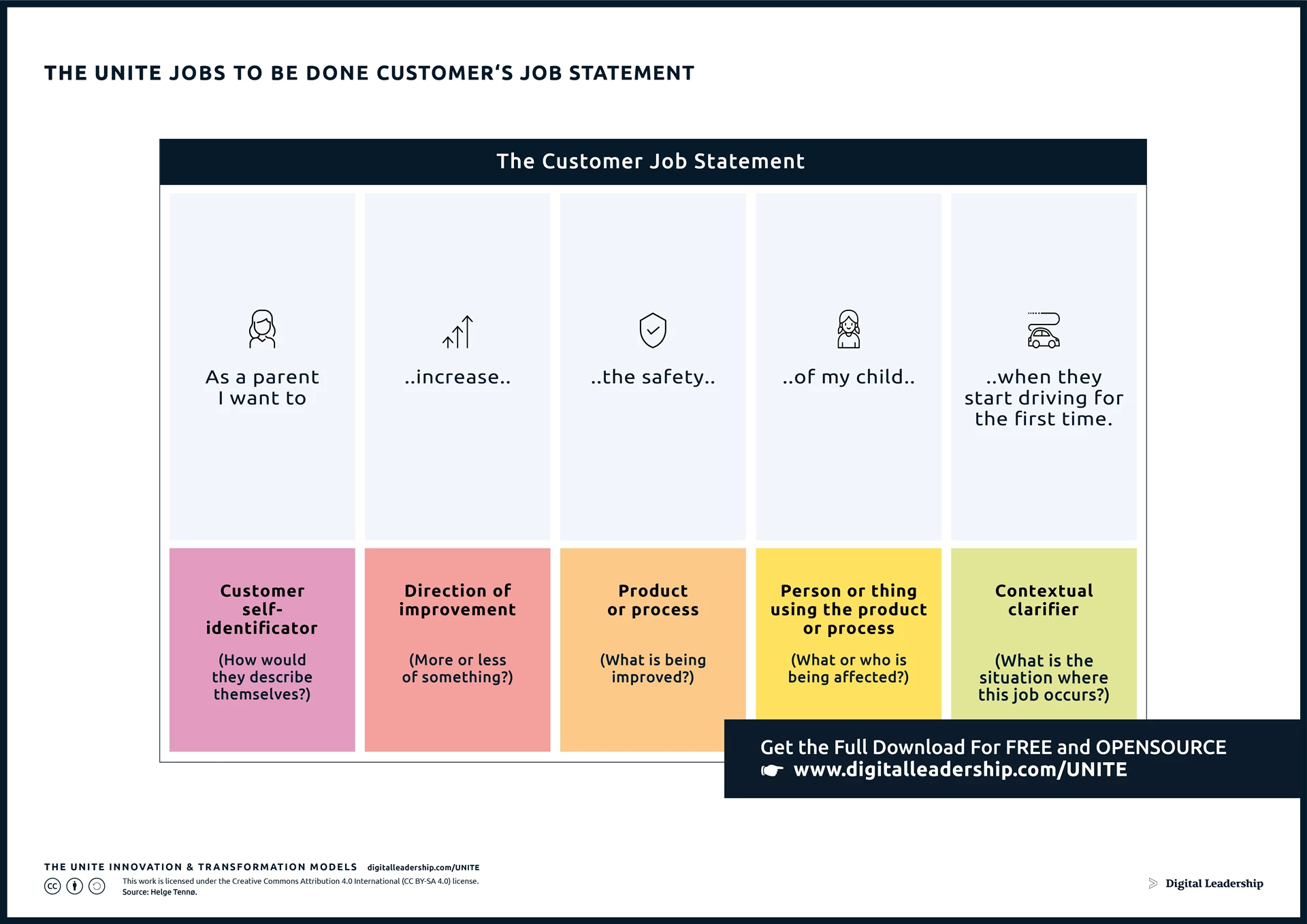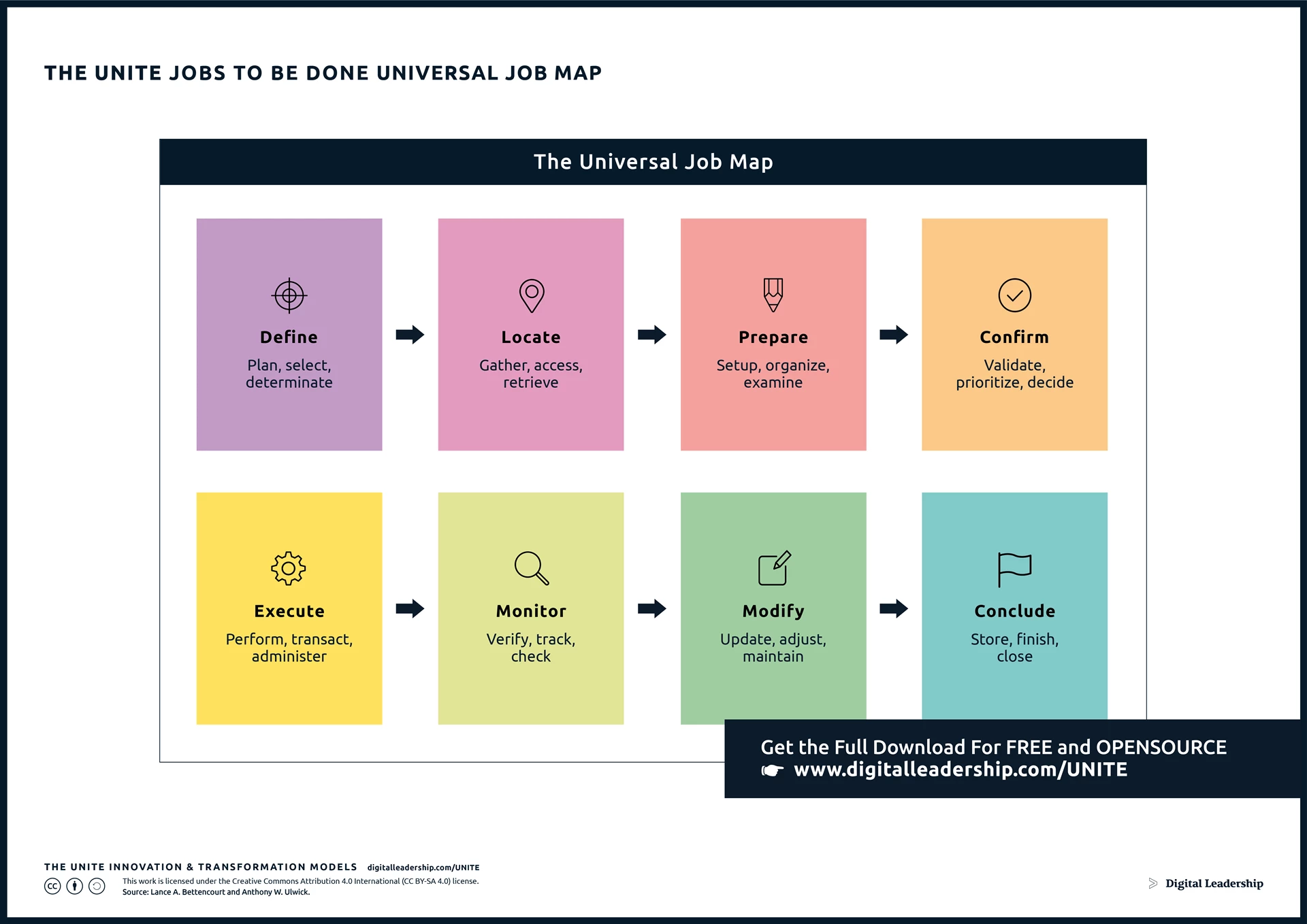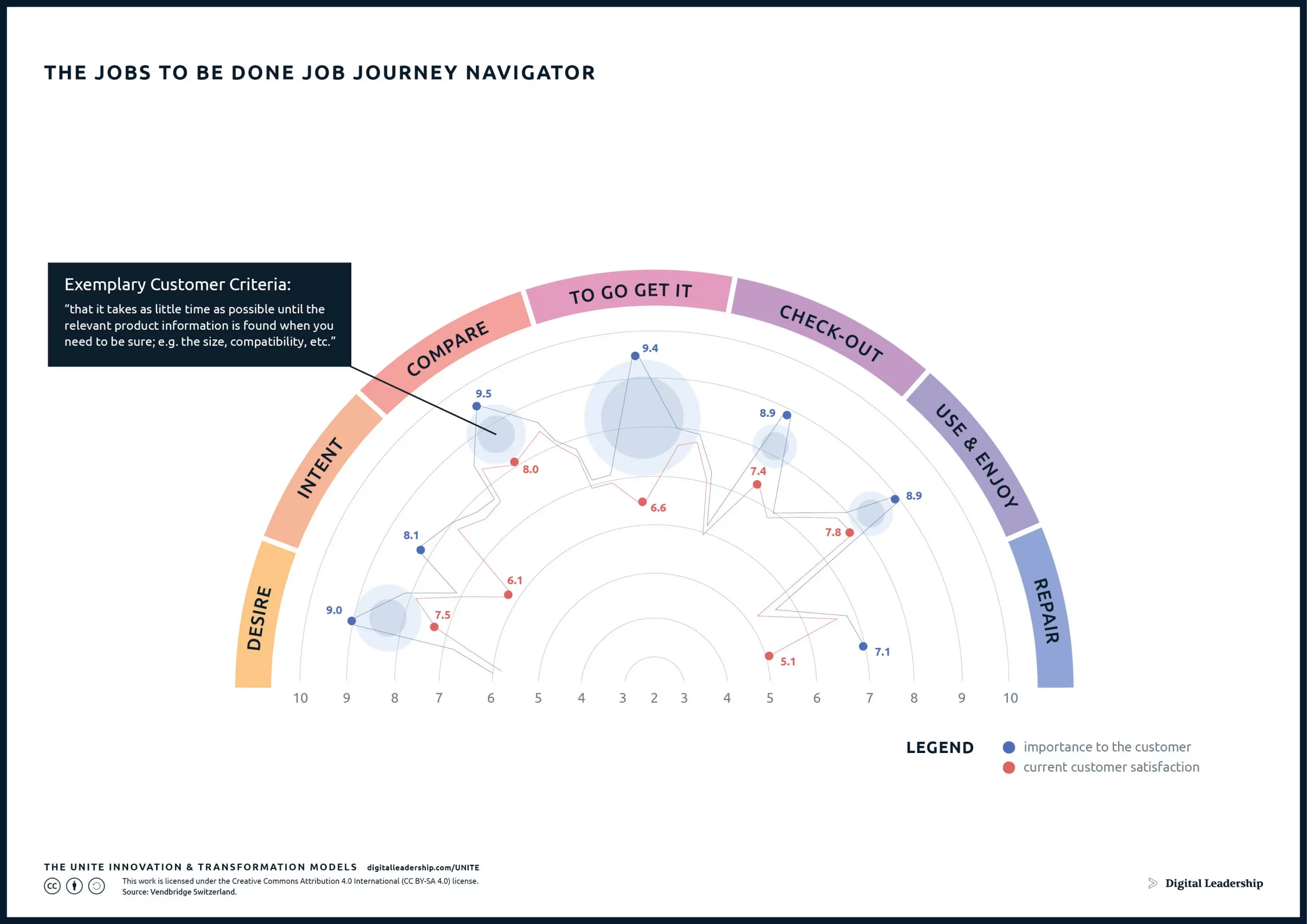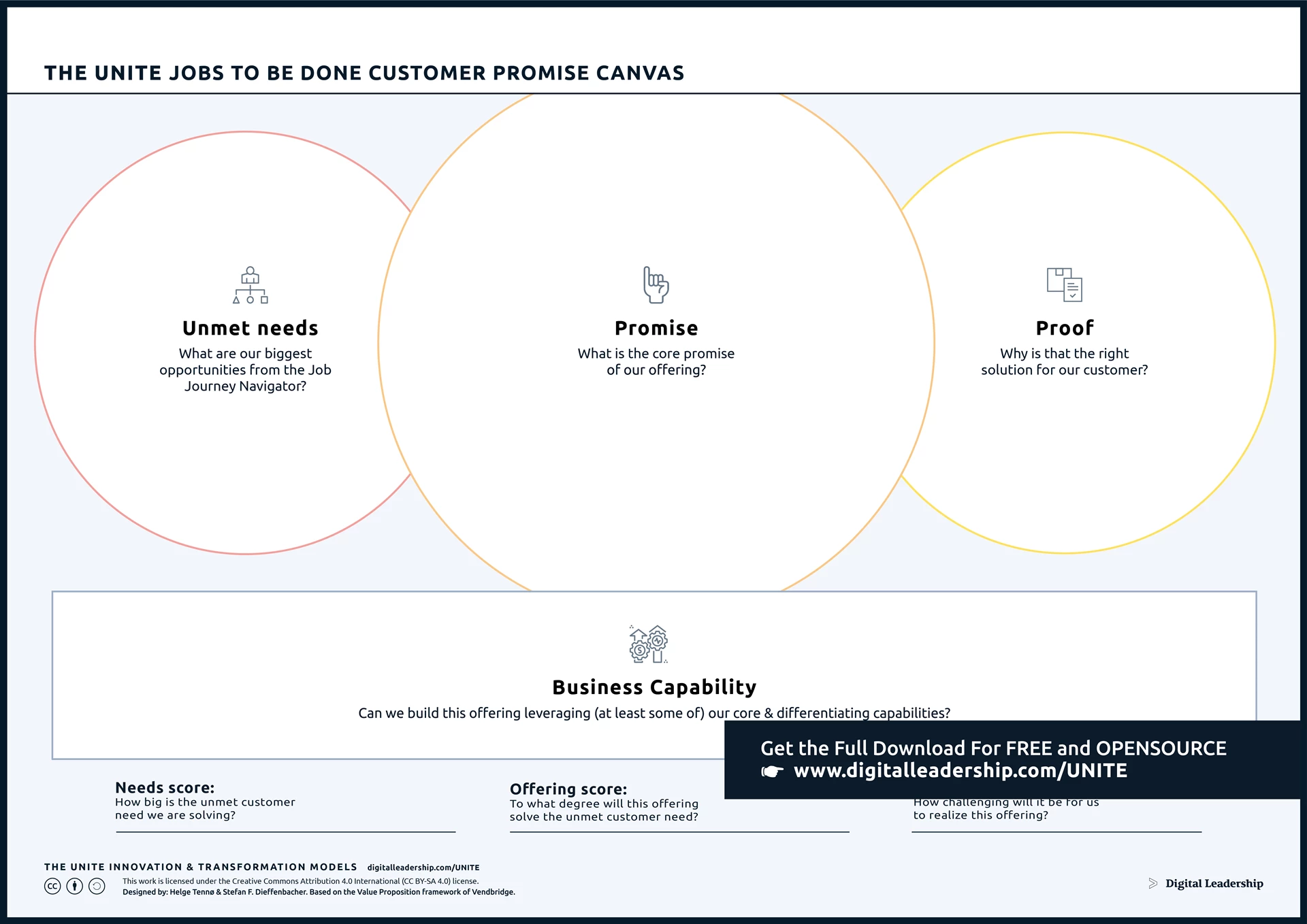Jobs to be done in Marketing Successful Implementation

The Jobs to be Done (JTBD) with an effective digital transformation strategy and innovation strategy emerges as a powerful tool, offering a fresh perspective on understanding customer motivations and driving marketing success. The comprehension and resolution of Jobs to be Done stand at the forefront, underscoring their significance in orchestrating effective digital transformation and fostering innovation in marketing within the broader business strategy.
In the dynamic realm of digital strategy and execution, Digital Leadership stands as a beacon of expertise, guiding organizations through disruptive change. As catalysts for positive transformation, we believe in leveraging emerging technologies and innovative digital business models to revolutionize customer service. This article explores the profound impact of Jobs to Be Done (JTBD) theory in the field of marketing, shedding light on its significance and providing valuable insights for business entrepreneurs.
Digital Leadership stands as a transformative force in marketing, integrating Jobs to be Done principles seamlessly into its suite of services. We provide Marketing Strategy Consulting and Digital Transformation Solutions to guide force for organizations, decoding crucial customer jobs that serve as the cornerstone for resonant marketing initiatives and support the execution of personalized strategies at scale, fostering a consistent and customer-centric approach.
What is Jobs to Be Done Theory
The Jobs to be Done (JTBD) theory, introduced by Clayton Christensen, fundamentally transforms the traditional approach to understanding customer behavior. Unlike conventional product-centric strategies, JTBD focuses on the notion that customers “hire” products or services to fulfill specific tasks or address particular needs in their lives. It centers on recognizing the functional, emotional, and social dimensions of customers’ motivations. At its core, JTBD involves crafting a clear Job Statement, mapping out the customer’s journey through a Job Map, and identifying the criteria customers use to evaluate the success of a job.
The Jobs to be Done (JTBD) theory in marketing revolves around understanding and addressing the fundamental needs and motivations that drive consumers to purchase or use a product or service. It emphasizes that customers “hire” a product or service to fulfill a specific job or task in their lives. Instead of solely focusing on demographics or features, JTBD theory delves into the context and circumstances under which customers make choices. By identifying the jobs customers are trying to accomplish, businesses can tailor their marketing strategies to provide solutions that precisely meet those needs. This customer-centric approach fosters innovation, enhances user experiences, and ultimately contributes to the success of marketing efforts.
Much more about Jobs to be done and other approaches to innovation strategy you will find in our brand-new FREE book “How to Create Innovation” Register for the download now!
Jobs to Be Done Benefits for Product Marketers
Product marketers play a crucial role in conveying value to customers. Here, we explore the specific benefits that JTBD brings to the realm of product marketing, offering insights into creating compelling narratives and resonating with target audiences.
- Customer-Centric Approach:
- JTBD emphasizes understanding customers’ fundamental needs and motivations, allowing product marketers to align strategies with authentic customer requirements.
- Targeted Marketing Strategies:
- By identifying specific jobs that customers are trying to accomplish, product marketers can tailor marketing messages and campaigns more precisely, resonating with the core needs of the target audience.
- Innovation Guidance:
- JTBD helps product marketers identify opportunities for innovation by uncovering unmet customer needs. This guidance ensures that product development efforts align with genuine customer motivations.
- Improved Product Positioning:
- Understanding the jobs customers hire a product to do enables marketers to position the product more effectively in the market. It helps communicate the value proposition in a way that directly addresses customer needs.
- Enhanced Customer Segmentation:
- JTBD provides insights into diverse customer segments based on the jobs they are trying to accomplish. Product marketers can use this information to create targeted campaigns for different customer groups.
- Effective Communication Strategy:
- With a clear understanding of customer jobs, product marketers can craft messaging that directly speaks to customers’ motivations. This results in more compelling and resonant communication strategies.
- Competitive Advantage:
- Leveraging JTBD insights can provide a competitive advantage by addressing customer needs that competitors might overlook. It allows product marketers to differentiate their offerings more effectively.
- Optimized Product Development:
- JTBD helps in prioritizing features and improvements based on their impact on critical customer jobs. This optimization ensures that product development efforts are aligned with the most significant customer needs.
- Customer Satisfaction and Loyalty:
- By focusing on the jobs that matter most to customers, product marketers can enhance overall customer satisfaction and foster loyalty. Satisfied customers are more likely to become repeat buyers and advocates for the brand.
- Strategic Decision-Making:
- JTBD provides a framework for making strategic decisions related to product development, marketing, and innovation. It ensures that decisions are grounded in a deep understanding of underserved customer needs.
- Adaptability to Changing Markets:
- Understanding customer jobs helps product marketers adapt to evolving market conditions. By staying attuned to changing customer needs, marketers can adjust strategies and offerings accordingly.
Successful Implementation of Jobs to be Done Framework in Marketing Steps
Successfully implementing the Jobs to be Done (JTBD) theory in marketing involves a strategic approach that aligns with the core principles of understanding customer needs and motivations. Here are the key steps for a successful implementation:
Step 1: Research and Identify Customer Jobs Statement
Begin the process by conducting qualitative interviews, surveys, and in-depth data analysis. These methods are essential for uncovering the fundamental jobs that customers are attempting to accomplish. Leverage techniques such as social listening and participation in online forums to gain insights from natural conversations. By combining these approaches, businesses can gather rich qualitative data that forms the foundation for understanding customer needs.
The UNITE JTBD Customer’s Job Statement Model serves as a robust framework, guaranteeing the generation of clear, insightful, and solution-agnostic statements. These statements, pivotal in the Jobs to Be Done (JTBD) Framework, go beyond mere descriptions, providing deep insights into authentic customer needs. This alignment of organizational strategies with customer needs is instrumental in fostering a profound understanding of an effective JTBD process, especially in the domains of product management and marketing.

Designed by: Digital Leadership AG – Source: Helge Tennø.
Your download is now available!
You can now access the complete JTBD Customer’s Job Statement Package, including a full presentation, related models and instructions for use.
Step 2: Create a Job Map
Develop a comprehensive Job Map that outlines the various steps and tasks customers undertake to accomplish a specific job. Utilize the eight steps of the Job Mapping process to delve into smaller tasks and activities within the overall customer journey. This mapping process provides a visual representation of the entire customer journey, offering valuable insights into the intricacies of their interactions and needs.
Incorporating “The UNITE Jobs to Be Done Universal Map” Model enhances this step, offering a visual representation that ensures a comprehensive understanding of the customer journey, specifically within the context of marketing. This approach becomes invaluable for businesses looking to align their marketing strategies with the identified jobs effectively. The visual representation aids in navigating the complexities of customer needs and behavior, guiding marketing teams toward more informed and strategic decision-making.

Designed by: Digital Leadership AG – Source: Lance A. Bettencourt and Anthony W. Ulwick.
Your download is now available!
You can now access the complete Jobs to be Done Universal Map Package, including a full presentation, related models and instructions for use.
Step 3: Identifying Customer Jobs through interviews
- User Qualitative Interviews and Observations: Direct interaction offers valuable qualitative data.
- Surveys and Questionnaires: Structured tools quantify user jobs from a diverse user base.
- Data Analysis from User Interactions: Analyzing User Behaviour Unveils Implicit Jobs.
- Social Listening and Online Forums: Monitoring discussions provides insights from natural conversations.
The UNITE Jobs-to-be-Done template is recommended for defining Customer Criteria, offering a structured approach to gathering essential information for the marketing process. This methodology encourages a holistic understanding the unmet customer needs and preferences, ensuring that products align closely with the jobs customers are trying to get done in the context of marketing. This approach becomes a cornerstone for strategic marketing decisions, allowing businesses to tailor their products and campaigns to better resonate with the identified customer jobs.

Designed by: Digital Leadership AG – Source: Strategyn
Your download is now available!
You can now access the complete Jobs to Be Done Template for Defining Customer Criteria Package, including a full presentation, related models and instructions for use.
Step 4: Opportunities Identification
In the Jobs to be Done (JTBD) methodology, identifying significant opportunities is a crucial step that steers the direction of marketing strategy. This phase involves translating qualitative insights gained from customer interactions into actionable opportunities for marketing improvement.
- Evaluate and identify potential opportunities for enhancing your marketing strategy based on customer insights and pain points.
- Explore areas where your marketing efforts can better align with the identified jobs of your target audience.
Leveraging tools like the Job Journey Navigator, such as the one provided by Vendbridge, proves invaluable not only in marketing strategy but also in product development. This tool meticulously maps out each Customer Criterion, aligning it with the earlier established Job Map. The visualization serves as a guiding compass for the marketing team, aiding in the seamless identification of substantial opportunities. This, in turn, streamlines the prioritization process, paving the way for envisioning potential solutions in both marketing and product development spheres.

Designed by: Digital Leadership AG – Source: Vendbridge Switzerland.
Your download is now available!
You can now access the complete Jobs to Be Done Journey Navigator Package, including a full presentation, related models and instructions for use.
Step 5: Integrate JTBD into Marketing Strategie
Embed JTBD principles into overall marketing strategies, ensuring that product positioning, messaging, and campaigns align closely with the identified customer jobs. This integration fosters a customer-centric approach that resonates with the core needs and motivations of the target audience.
By incorporating JTBD principles into marketing strategies, businesses can develop targeted and compelling campaigns that directly address the jobs customers are trying to get done. This customer-centric approach enhances the relevance of marketing messages, positioning products as solutions that align with the specific needs and desires of the audience. This strategic alignment contributes to increased resonance, customer engagement, and the overall effectiveness of marketing initiatives. Moreover, the integration of JTBD into marketing strategies facilitates a more meaningful connection between the brand and its audience, resulting in enhanced customer loyalty and satisfaction.
Step 6: Design Solutions for Desired Outcomes
Engage in collaborative design thinking sessions to generate creative solutions aligned with identified opportunities. Rapidly prototype and test these solutions based on user feedback. Apply usability heuristics and integrate contextual inquiry for real-world insights, ensuring that the designed solutions effectively meet customer expectations.

Designed by: Helge Tennø & Stefan F. Dieffenbacher. Based on the Value Proposition framework of Vendbridge
Your download is now available!
You can now access the complete Jobs to Be Done Customer Promise Canvas Package, including a full presentation, related models and instructions for use.
Step 7: Measure and Track Success
Establish key performance indicators (KPIs) to measure the success of implemented solutions. Track and analyze user interactions, customer satisfaction levels, and business outcomes. This continuous monitoring provides valuable feedback for refining strategies and ensuring ongoing success.
Jobs to Be Done Examples in Marketing
- Social Media Engagement:
- Job to Be Done: “As a business owner, I want to increase social media engagement to enhance brand visibility and reach a broader audience.”
- Outcome: Implementing a social media marketing strategy that encourages audience interaction and sharing, leading to increased brand awareness and online presence.
- Lead Generation Optimization:
- Job to Be Done: “As a marketing professional, I want to optimize lead generation to attract potential customers and drive conversions.”
- Outcome: Developing targeted lead generation campaigns, utilizing effective channels and strategies, resulting in a consistent flow of qualified leads for the sales team.
- Customer Retention Enhancement:
- Job to Be Done: “As a brand, I want to enhance customer retention to build long-term relationships and foster loyalty.”
- Outcome: Implementing customer loyalty programs, personalized communication, and post-purchase engagement strategies to increase customer satisfaction and loyalty.
- Brand Positioning and Differentiation:
- Job to Be Done: “As a marketing team, we want to position our brand effectively and differentiate ourselves from competitors.”
- Outcome: Crafting and communicating a unique value proposition, creating a strong brand identity, and showcasing key differentiators in marketing materials.
- Content Consumption Facilitation:
- Job to Be Done: “As a content creator, I want to facilitate easy content consumption to keep the audience engaged and informed.”
- Outcome: Developing user-friendly content formats, optimizing website and platform layouts for seamless navigation, and providing valuable content that meets audience needs.
- Consumer Trust Building:
- Job to Be Done: “As a company, we want to build consumer trust through transparent and ethical marketing practices.”
- Outcome: Communicating brand values, ensuring transparency in marketing communications, and actively addressing customer concerns to build trust and credibility.
- Influencer Collaboration Strategy:
- Job to Be Done: “As a brand, I want to leverage influencer collaborations to enhance credibility and reach a specific target audience.”
- Outcome: Identifying and partnering with influencers whose values align with the brand, resulting in increased credibility, audience reach, and product endorsements.
- Data-Driven Decision-Making:
- Job to Be Done: “As a marketing team, we want to make data-driven decisions to optimize campaign performance and maximize ROI.”
- Outcome: Implementing analytics tools, gathering and analyzing marketing data, and using insights to refine marketing strategies for improved effectiveness.
Benefits and Challenges of JTBD in Marketing
While JTBD in marketing offers substantial benefits, organizations need to address specific challenges to fully leverage its potential. Strategic implementation and ongoing efforts to overcome challenges contribute to the successful integration of JTBD principles in marketing strategies.
| Aspect | Benefits of JTBD in Marketing | Challenges of JTBD in Marketing |
|---|---|---|
| Customer-Centric Strategy | – Enables adoption of a customer-centric strategy by aligning with genuine customer needs. | – Collecting and analyzing data related to customer jobs can be complex and may require significant resources and time. |
| Targeted Messaging | – Identifying specific jobs enables the creation of targeted messages that address customer needs effectively. | – Identifying implicit customer needs within the JTBD framework can be challenging, requiring a nuanced understanding of customer behavior and motivations. |
| Innovation Catalyst | – Serves as a catalyst for innovation by guiding marketers to identify unmet customer needs. | – Striking a balance between addressing immediate customer needs and pursuing long-term strategic goals can pose a challenge in JTBD implementation. |
| Optimized Product Positioning | – Helps in positioning products effectively in the market by emphasizing value propositions aligned with customer needs. | – Integrating JTBD into existing marketing processes and strategies may require organizational changes and a cultural shift, presenting implementation challenges. |
| Enhanced Customer Segmentation | – Facilitates improved customer segmentation, allowing tailored campaigns based on the jobs customers are trying to fulfill. | – Resistance from stakeholders accustomed to traditional marketing approaches may hinder the smooth adoption of JTBD principles, requiring change management efforts. |
| Improved Communication Strategies | – Provides a clear understanding of customer jobs, enabling the development of communication strategies that resonate with core motivations. | – Relying on customer feedback for JTBD insights may pose challenges if the feedback is limited or biased, potentially affecting the accuracy of identified customer jobs. |
| Competitive Advantage | – Leveraging JTBD insights provides a competitive advantage by comprehensively addressing customer needs. | – Managing competing priorities within marketing teams, such as immediate campaign needs versus long-term JTBD goals, can be a challenge. |
| Optimized Product Development | – Helps prioritize features and improvements based on their impact on critical customer jobs, ensuring alignment with significant needs. | – Staying attuned to continuously evolving customer needs and adjusting marketing strategies accordingly requires ongoing effort and adaptability. |
| Customer Satisfaction and Loyalty | – Focusing on critical customer jobs enhances overall satisfaction and fosters loyalty as products are designed to meet essential needs. | – Ensuring that marketing teams are adequately educated on JTBD principles and methodologies is crucial for successful implementation. |
| Strategic Decision-Making | – JTBD offers a framework for making strategic decisions related to product development, marketing, and innovation. | – Establishing clear metrics to measure the impact of JTBD on marketing efforts and outcomes can be challenging but is essential for ongoing improvement. |
| Adaptability to Changing Markets | – Understanding customer jobs helps marketers adapt to evolving market conditions, allowing adjustments to strategies based on changing needs. |
Overcoming Marketing Challenges with JTBD
Implementing Jobs to Be Done (JTBD) in marketing presents numerous benefits, yet organizations may encounter challenges along the way. Addressing and overcoming these challenges is crucial for successful JTBD integration. Let’s explore strategies to overcome common marketing challenges associated with JTBD:
- Customer-Centric Strategy:
- Challenge:
- Shifting from a product-centric to a customer-centric strategy may face resistance from internal stakeholders.
- Strategy:
- Conduct workshops and training sessions to communicate the benefits of a customer-centric approach. Showcase successful case studies to emphasize the positive outcomes.
- Challenge:
- Targeted Messaging:
- Challenge:
- Crafting messaging that resonates with diverse customer segments and their specific jobs can be complex.
- Strategy:
- Utilize JTBD insights to create buyer personas aligned with customer jobs. Implement A/B testing for messaging to identify the most effective communication strategies.
- Challenge:
- Innovation Catalyst:
- Challenge:
- Fostering innovation culture may face resistance in traditional organizational structures.
- Strategy:
- Establish an innovation task force or department. Encourage cross-functional collaboration and generate innovative ideas. Showcase how JTBD insights drive innovation.
- Challenge:
- Optimized Product Positioning:
- Challenge:
- Ensuring consistent and effective product positioning across various channels can be challenging.
- Strategy:
- Develop a centralized positioning document based on JTBD insights. Implement regular training sessions for marketing teams to align with this positioning.
- Challenge:
- Enhanced Customer Segmentation:
- Challenge:
- Traditional demographic-based segmentation may not capture the nuanced needs identified by JTBD.
- Strategy:
- Combine demographic data with JTBD insights for more refined segmentation. Use behavioural data to identify shared jobs among diverse demographics.
- Challenge:
- Improved Communication Strategies:
- Challenge:
- Adapting communication strategies based on dynamic customer needs can be challenging.
- Strategy:
- Implement real-time monitoring of customer feedback and adjust communication strategies accordingly. Foster open communication channels for quick adaptation.
- Challenge:
- Competitive Advantage:
- Challenge:
- Competitors may also adopt JTBD, making it crucial to continually innovate.
- Strategy:
- Regularly update JTBD insights and stay ahead by anticipating evolving customer needs. Leverage early adopter advantages to solidify market positioning.
- Challenge:
- Optimized Product Development:
- Challenge:
- Balancing the speed of product development with thorough JTBD analysis may pose challenges.
- Strategy:
- Adopt agile methodologies to iteratively develop products based on continuous JTBD insights. Conduct sprints and prioritize features aligned with high-impact customer jobs.
- Challenge:
- Customer Satisfaction and Loyalty:
- Challenge:
- Meeting ever-evolving customer expectations requires constant adaptation.
- Strategy:
- Implement ongoing customer feedback mechanisms aligned with JTBD. Use loyalty programs to reinforce positive experiences related to key customer jobs.
- Challenge:
- Strategic Decision-Making:
- Challenge:
- Traditional decision-making processes may not incorporate JTBD insights.
- Strategy:
- Integrate JTBD principles into strategic planning sessions. Develop decision frameworks that consider the impact on critical customer jobs.
- Challenge:
- Adaptability to Changing Markets:
- Challenge:
- Rapid market changes may outpace traditional marketing strategies.
- Strategy:
- Leverage JTBD as a dynamic tool for market adaptation. Implement regular environmental scanning and scenario planning sessions to anticipate changes.
- Challenge:
Conclusion
In conclusion, the Jobs to Be Done framework emerges as a transformative force in the realm of marketing. Digital Leadership’s commitment to innovation and digital transformation aligns seamlessly with the principles of JTBD, providing businesses with a powerful tool to enhance value creation, understand unmet customer needs, and drive sustainable change in the ever-evolving digital landscape. As we navigate the intricate landscape of marketing, embracing JTBD can be the key to unlocking unprecedented success and resonating with customers on a profound level.
Recent Posts

Business Level Strategy Examples, Types, Definition and Implementing Steps For Successful Strategy
Social ShareIn the business environment, the choice of an effective strategy can...
View Full article
Radical Innovation Meaning, Examples and Characteristics
Social ShareRadical innovation is a main type of innoavtion that involves the...
View Full article





























 Book How to Create Innovation
Book How to Create Innovation